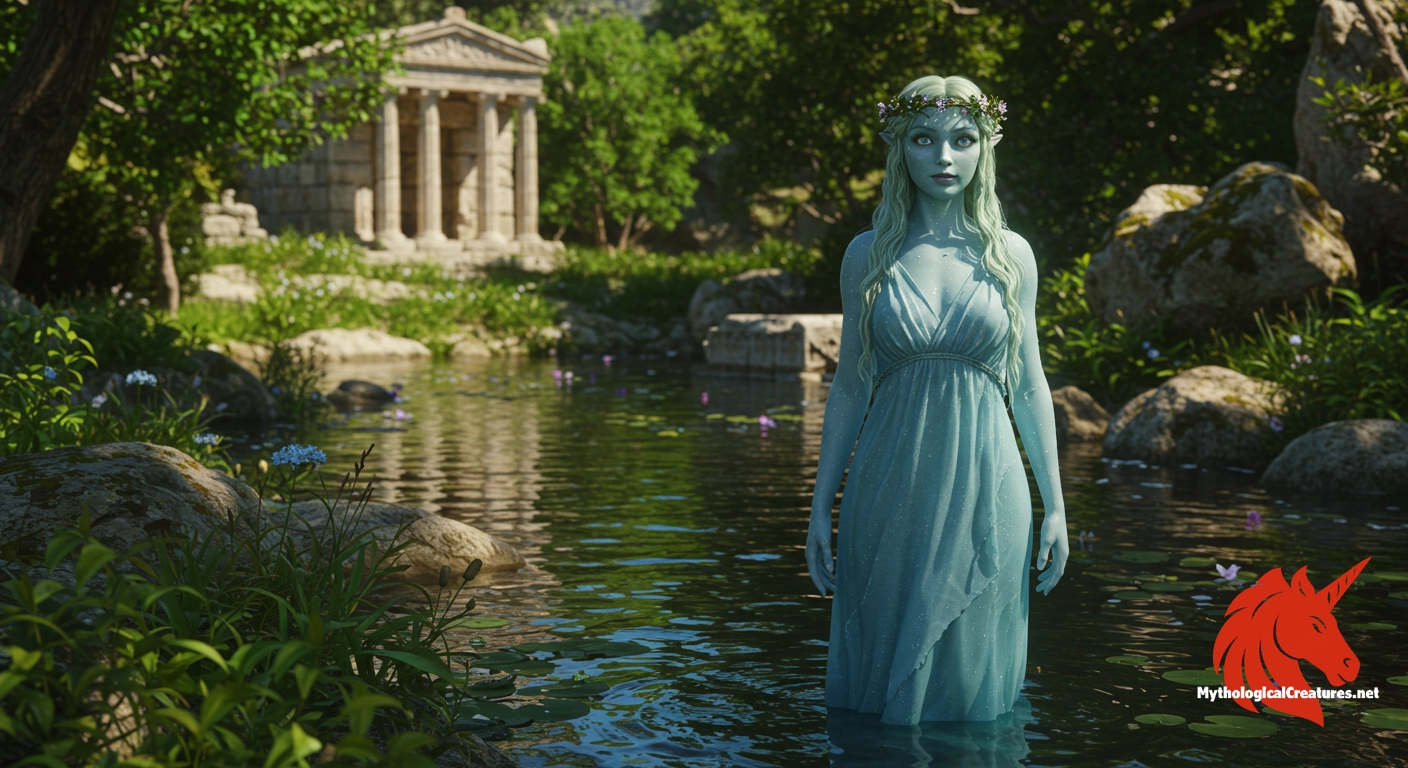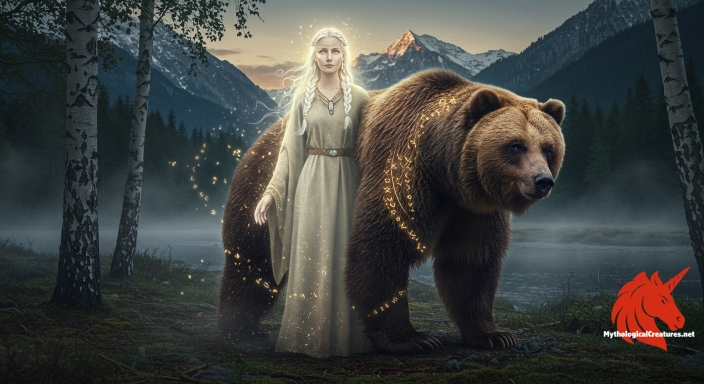Diogenia: Diogenia is an Athenian naiad from Greek mythology known for her divine association with the Cephisus River.

Diogenia
Diogenia - Her myth underscores the importance of freshwater sources in Athenian culture and links divine ancestry to the Athenian royal lineage.
Origins & First Encounters
Diogenia emerges as a distinctive figure within Athenian mythology, celebrated for her intrinsic connection to the life-giving power of water. Born as a naiad and daughter of the venerable river-god Cephisus, her origins are steeped in the natural spirituality that characterised ancient Athens. Her mythos intricately links the divine with the mortal realm, displaying the harmonious relationship between nature and civilisation. Through her union with Phrasimus, Diogenia helped forge a celebrated lineage that resonated with the civic and religious fabric of the city. The ensuing generations, particularly through her daughter Praxithea who married the illustrious Erechtheus, cemented her role in the formation of Athenian identity. Her story symbolises the seamless merging of elemental forces with human endeavours, rendering her a pivotal bridge between nature and mankind. The narrative also reflects a broader reverence for water deities, whose fluid presence was synonymous with renewal and fertility. Her legacy is enriched by the allegorical links that bind the natural landscape to the divine forces of the ancient world. Over time, the tale of Diogenia has served as a subtle but enduring reminder of the sacred interplay between water and the destiny of a people.
Source Texts & Tale Variants
Ancient records and fragmentary texts have preserved the essence of Diogenia’s myth, even if her story does not command the prominence of other deities. Various scholia and genealogical listings in early Athenian sources mention her as a significant naiad, thereby integrating her into the broader tapestry of local lore. Some of the surviving texts hint at her familial connections, particularly her linkage to the river god Cephisus and the consequential union with Phrasimus. While detailed narratives are sparse, inscriptions and early commentaries have provided glimpses into how her myth was interwoven with civic tradition. Local cultic practices occasionally celebrated water deities, thereby ensuring that figures like Diogenia maintained a ritual presence. The sparse literary references have been bolstered over time by vase paintings and iconographic motifs that capture her ethereal nature. Diverse accounts and regional manuscripts, though sometimes variant in details, reaffirm her role as a symbolic mediator between the divine and earthly realms. In gathering these fragmented sources, modern interpretations continue to reconstruct the multifaceted dimensions of her character, balancing literary evidence with artistic representations.
Form & Powers
In visual depictions, Diogenia is portrayed as a being of sublime and delicate beauty, embodying the grace of flowing water. Her appearance is often rendered with a luminous quality that seems to capture the reflective shimmer of a pristine river. Artists frequently illustrate her with cascading, wavy hair that mirrors the natural movements of water and is sometimes entwined with floral and aquatic adornments. Her eyes are depicted as reflective pools, suggesting both mystery and an ancient wisdom that transcends mortal understanding. The statues and illustrations attribute to her an elegance that is both slender and resilient, a subtle blend of strength and fragility. Her attire, typically envisaged as diaphanous and fluid, appears to merge with the natural elements, evoking images of soft, rippling water. These portrayals are infused with intricate details that highlight motifs of nature, such as delicate patterns that echo the movement of river currents. Although literary sources do not exhaustively detail her form, the continuous artistic tradition paints Diogenia as an embodiment of water’s serene and potent influence. Her physical manifestation, as reconstructed through myriad visual arts, continues to inspire awe and reverence for her celestial beauty.
Regional Faces
While Diogenia is chiefly celebrated within Athenian mythology, her influence subtly permeates regional variations across ancient Greece. In the core of Attica, she was revered as a guardian of freshwater sources, with local rituals incorporating her presence as part of broader water worship. In some local traditions, her narrative was adapted to blend with regional landscapes, imparting her with characteristics that resonated with the local environment. The transformation of her story in these areas often highlighted her role as a protective spirit, a nurturer of the fertile lands adjacent to flowing rivers. Variations in her depiction sometimes merged her identity with other minor water divinities, outlining a shared symbolism among neighbouring communities. The localized reinterpretations allowed for the integration of natural landmarks into her myth, ensuring that her divine essence was reflected in the rural and urban geography alike. Such variations underscore the flexibility of myth-making, where a deity's attributes are recalibrated according to local customs and environmental circumstances. Over time, these regional adaptations have enriched the overarching narrative of Diogenia, confirming her status as not only an Athenian naiad but also as a representative of nature's omnipresent influence. This geographic spread of her myth underscores the widespread cultural significance attributed to water deities throughout ancient Greek society.
Cultural Parallels
Diogenia’s role as a naiad finds interesting parallels with other water deities in Greek mythology and beyond. Her ethereal presence and nurturing attributes invite comparisons with figures like Arethusa, whose myth similarly encapsulates the enigmatic beauty of freshwater realms. Her narrative also aligns with the cyclical themes of fertility and renewal, a motif common among water spirits across various cultural mythologies. In the Mediterranean context, deities of water, like those in Roman traditions, often served as intercessors between the natural world and human civilisation, an aspect vividly present in Diogenia’s story. Comparable in their elemental symbolism are the nymphs of other ancient cultures, each celebrated for encapsulating the life-sustaining qualities of water. This overlap in divine roles emphasizes a universal cultural reverence for water as both a literal resource and a spiritual emblem. The comparative study reveals that while the names and rituals may differ, the intrinsic portrayal of water deities as both protective and transformative remains constant. Such analyses highlight Diogenia’s contribution to a global metaphor where water is intertwined with creation, healing, and eternal change. By examining her myth alongside similar figures, one can appreciate the shared narrative threads that link disparate cultural traditions through the sanctity of water.
Legacy & Modern Evolution
The myth of Diogenia has traversed centuries, adapting to the evolving cultural and artistic landscapes while retaining its core essence. In antiquity, her story was interwoven with the civic identity of Athens, reinforcing the divine origins of its most illustrious traditions. Over time, as the society transitioned through various epochs, Diogenia’s representation was gradually reinterpreted through the lenses of emerging artistic and literary movements. Elements of her myth have been resurrected in Neoclassical art and literature, where the allure of classical antiquity was celebrated anew. Modern reinterpretations often view her not only as a mythological figure but also as a symbol of nature’s enduring grace, inspiring contemporary narratives about environmental stewardship. Her imagery, replete with the themes of renewal and continuity, resonates with the modern ecological consciousness. The evolution of her myth reflects an ongoing dialogue between past and present, bridging the gap through timeless symbols of water and life. In academic and creative circles alike, Diogenia continues to inspire new interpretations that affirm the universal and perpetual allure of the natural world. Thus, her legacy endures as a multifaceted emblem of both ancient divinity and modern environmental ethos.
Interesting Fact
An interesting aspect of Diogenia's myth is how it intertwines the natural world with the origins of Athenian royalty, highlighting the ancient Greek tendency to personify natural elements as divine progenitors of cultural identity.
Quick Creature Info
Origin:
Features:
Associations:
Our Mythic Legendary Rating:

Habitat:
Supernatural Powers:
Physical Attributes:
Abilities:
Behavior:
Lore:
References
Discover Another Mythical Legend You May Not Have Heard Of?
Uncover the mysteries of ancient folklore and expand your knowledge of legendary beings from cultures around the world.
Dare to Meet the Hamingja....
Mythical Disclaimer: The images and data on this site are derived from various historical and literary sources, but we have found that many myths often have multiple versions and interpretations across references, sometimes contradictory. As a result, these creature depictions are artistic interpretations—imaginative blends of folklore, legend, and a dash of AI guesswork. Because creature descriptions vary widely, our illustrations and accompanying information represent our best effort to honor mythology while bridging creative gaps. Enjoy these interpretations—just remember, we've done our best to respect the stories and validate available data, but in the realm of mythology, details often shift, imagination leads the way, and nothing is ever set in stone!
Curated by the Mythological Creatures Team (rev. May 2025)
